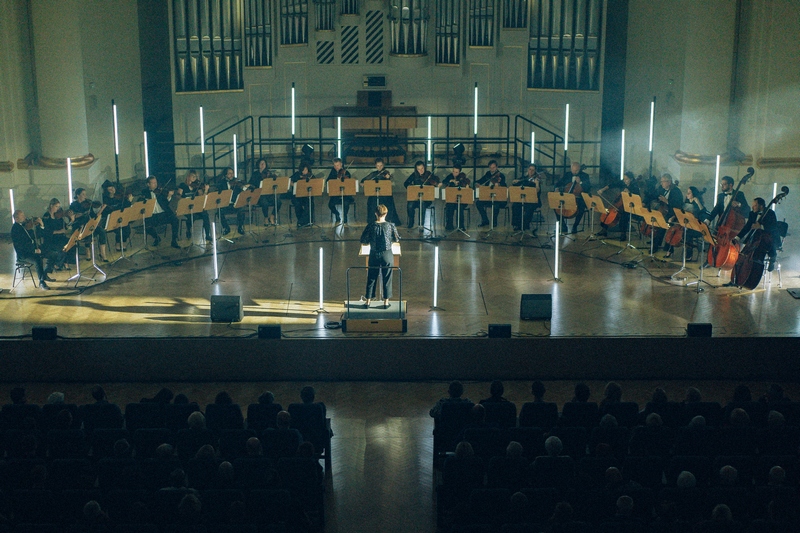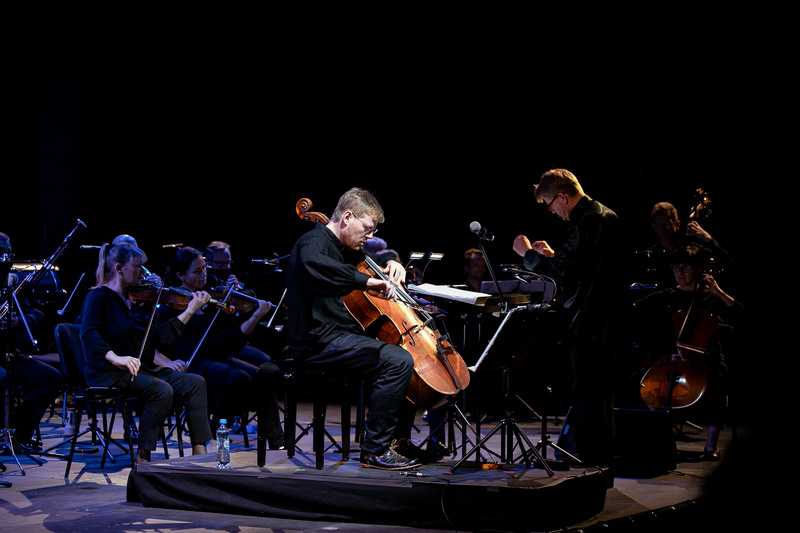
As well as the intimacy demonstrated in several concerts at this year’s Sacrum Profanum festival in Kraków, many of the other performances provided opportunities for immersive listening, often within the context of large-scale durations. Two of these, both examples of primary colour, bargain basement minimalism, may well have been striving for immersion but, unsurprisingly, turned out to be extremely difficult to tolerate. It’s a while since i’ve sat through this kind of thing, so it was interesting to discover that absence has only made this particular heart grow even less fond. And that’s saying something.
Tristan Perich‘s Open Symmetry, composed in 2018 but evidently wanting to sound exactly like music written several decades earlier, combined three percussionists (of course, it always has to be percussionists) with a large array of his trademark 1-bit electronic gizmos. The work’s constant slew of rudimentary arpeggios and rhythmic tremolandi became boring within the first 10 minutes, which was unfortunate as there were around 40 more minutes left to go. It’s only fair to say that the performers, members of Ensemble 0 and Elektro, executed the piece superbly, though with such escapist, populist fluff as this the effort didn’t seem remotely worth it, especially as what was coming out of the speakers was often more interesting than what they were doing. By comparison, Simeon ten Holt‘s Canto Ostinato, composed in 1976 and inflicted on us by Chain Ensemble, felt utterly sadistic. i struggle to recall a time when i’ve been forced to contend with such wilful, insufferable, unstoppable banality. The fact that the work was broken up by a sequence of electronics that all too briefly broke beyond its self-imposed drastic confines and entered a more imaginative soundworld (not part of the work but conceived by the ensemble), only made the reality of its dementia-like circling all the more egregious, torturous and asinine. Walkouts were increasingly frequent and numerous, and i have to confess that, in the end, pushed beyond my limits, i joined them. It’s hard to convey the happiness and relief i felt escaping into the cool evening air and the sight of a beautiful glowing sunset across the Vistula river – but the silence was a thousand times more golden.

Smaller-scale examples of immersion came in the festival’s opening evening, in a performance given by Sinfonietta Cracovia, conducted by Lilianna Krych. All three works had their own behavioural grammar, establishing the limits of their respective soundworld. In Tomasz Sikorski‘s Winter Landscape, a work from 1982, the music was caught in an oscillation between cross-tempi repetitions and rich, united phrases. This established a gentle but palpable tension, rocking between these in such a way that it felt that nothing could really get going, an impression reinforced later when the music seemed to be back where it started. Deeper still was Elongation of Nights by Justė Janulytė. Though it lasted barely eight minutes, time was complicated by the way the tempo sounded quick while the music seemed slow. Despite its nocturnal title, the work brought to mind the tentative fragility of early dawn; indeed, as it developed, one could read its gorgeous soundworld, an alternately laser-focused and shimmering radiance, as the sun as much as the moon. Though there were details everywhere, they were nonetheless part of the same overall dazzling texture of light, continuing in flux even as it receded, not fading into darkness but a kind of ‘sun-silence’, as if light and dark had been inverted. Perhaps dawn, finally, had come.

A similarly complex sense of time and movement filled Aleksandra Słyż‘s Pure Voices, receiving its first performance. Slow-moving chords moved in and out of harmonic clarity, though here too the notion of ‘slow’ was undermined by the nature of the material, particularly its use of semi-static progressions, seemingly resolved and unresolved simultaneously, and in the same way existing in an unclear space outside norms of consonance and dissonance. In the midst of all these uncertainties, Pure Voices seemed to be heading for a resolution that could feasibly take millenia to reach; its 20-minute span felt like a window into an almost infinitely greater sonic expanse.
The greatest examples of immersion came in a pair of hour-long performances that were the twin highlights of Sacrum Profanum. Wojtek Blecharz‘s Piano Concerto was erroneously billed as lasting 45 minutes, but its actual duration was closer to an hour. Pretty much my only previous encounter with Blecharz’s music was in 2017, when i was invited to Warsaw to experience his large-scale theatrical work Body-Opera. That piece took a structured but relaxed approach to performance, and absolutely the same could be said of the Piano Concerto. In lesser hands the work would have unfolded as a pretentious exercise in loose, meandering ideas emerging arbitrarily. However, Blecharz established a context for the piano via a collection of small portable loudspeakers (positioned at four stations at the cardinal points of the space). At times a meditative atmosphere, at times the focus of our attention, they served throughout to provide a unifying presence that helped to hold the loose structure together.

At the physical and sonic centre of this was pianist Rei Nakamura, manipulating the piano in a way that suggested she was only now getting to know the instrument. In contrast to the diaphanous electronic texture, Nakamura’s actions were highly tactile, touching, stroking and striking the insides of the piano with great delicacy, the resultant music almost lowercase in nature. Meanwhile, Blecharz (disconcertingly attired like a monk) roamed the space with the small speakers, coming across not unlike an exam invigilator keeping a close eye on proceedings. The speakers were literal satellites, but the piano material had a similar quality, like isolated pockets of ideas brought and placed togeher, adjacent, in succession, while we were invited to parse the meaning and any real or imagined connections between them. One of the most striking aspects of the Piano Concerto was its patience, allowing periods when the piano fell silent and the ambience hovered all around us, sometimes at the cusp of audibility. While it was tempting to watch everything going on, there actually wasn’t much point as the work’s elements cohered so much better without visual distractions, in the process gradually forging a stronger connection between the piano and electronics, the latter at times appearing to resonate the former. Though it was, ultimately, too long (and this performance also experienced a few walkouts), there was something undeniably mesmeric about the fluid interplay of its ideas, not only held together by Blecharz’s soundscape but also Nakamura’s low key but commanding presence as soloist.
The most stunning, and immersive, music of all was, appropriately, the final performance of the festival. Country, by Niels Rønsholdt, is described as a “concerto for voice, cello and chamber orchestra”, though in practice it’s an amalgamation of a concerto and a song cycle. Performed by soloist Jakob Kullberg with the New Music Orchestra conducted by Szymon Bywalec, the hour-long piece takes country music as inspiration for its sequence of 18 songs, though that description doesn’t remotely reflect the reality of what Country actually is, and what it does. Apropos: it took some time to get the measure of this work, to understand its peculiar musical language and grasp the relationship with its titular inspiration. The only way i can describe it is an extended homage captured in a sequence of half-remembered memories playing out within a dream. As such, at no point does the piece even slightly become pastiche, but instead it embodies a host of tropes and gestures from country music (both musical and lyrical) that become the basis for its clear but kaleidoscopic language.

As soloist, Kullberg alternated not only between cellist and vocalist, but also between cellist and pseudo-guitarist, picking and strumming his instrument like an eccentric kind of balladeer. Assorted members of the orchestra acted as backing vocalists from time to time, alongside an additional voice heard through loudspeakers. The half-remembered quality manifested in the way we heard not so much songs as snippets, portions of verse and refrain that would regularly become trapped as if stuck in a damaged groove on a record, repeating phrases again and again. As such, the 18 movements that make up Country often sounded like continuations or alternate sections of the same bigger song. This only made the whole experience more enveloping, surrounded by this world of allusive fragments, forming an entirely unpredictable yet coherent narrative. Despite being fragmented, broken and distorted, the most striking aspect of Country is the extent to which Rønsholdt imbues it with such raw lyricality. Of course, a work so rooted in song will inevitably be lyrical, but on numerous occasions this erupted in the most passionate melodic outpourings, like vivid bursts of climactic lucidity in an otherwise befuddled mind. Combined with its primary tendencies toward heartfelt tenderness and dark brooding, Country was an immensely moving experience. The entire performance was marvellous, but it’s impossible to imagine anyone other than Kullberg at the helm of this piece, tapping fully into his unique blend of eccentricity, virtuosity and intensity of expression.
